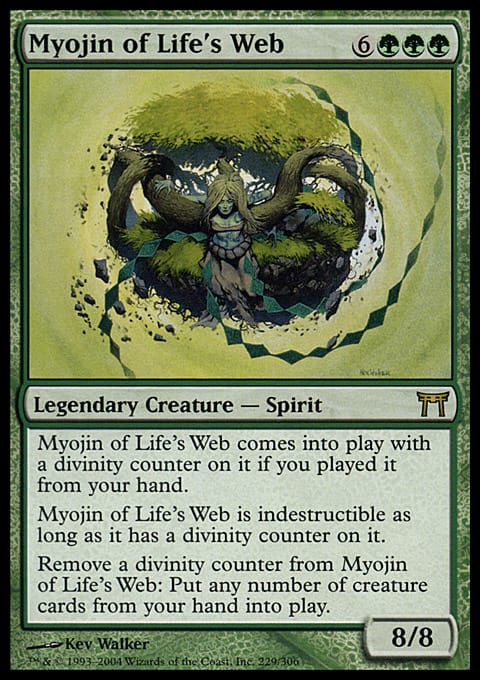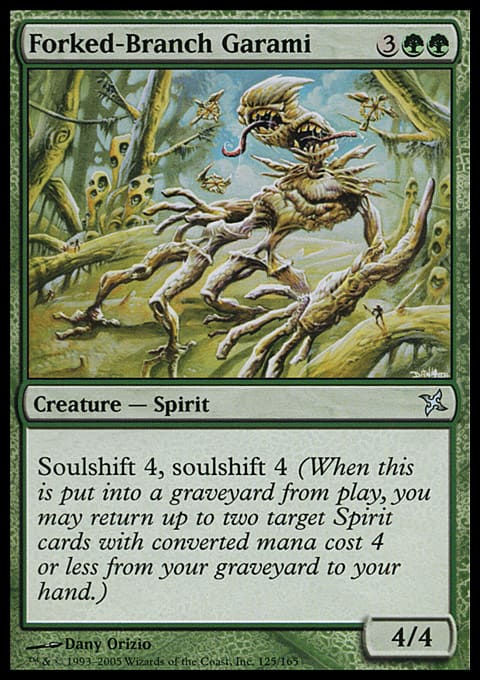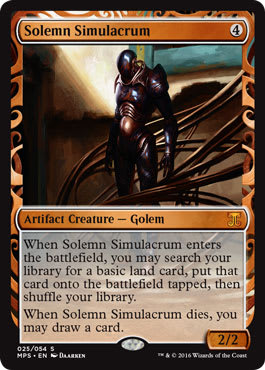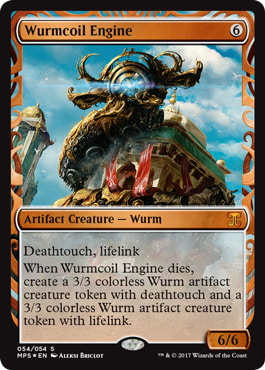
Last week, I talked about how I build Commander decks, and I presented a Mishra, Artificer Prodigy list. You all made it very clear that you wanted to see how I actually implement that advice in a step-by-step walkthrough, and faithful servant that I am, I’m going to oblige this week.
Step 1: Theming
You could just throw a bunch of cards that you like together and call it a day. In fact, many people do just that for their first Commander decks. Many more start off by picking out cards that are good in the format and going to town. There’s nothing inherently wrong with either of those approaches, but if you play a lot of Commander, things will stay much more interesting with varied card choices. But how do you know which cards to pick?
To put it plainly: Make your deck about something.
Build around your legend of choice, another interesting card, an ability, an interaction, or a type of gameplay. Build around something else entirely! Just pick something, and stick with it.
Remember:

– Mark Rosewater
To keep in theme with last week’s Mishra deck, I picked another legendary creature to build around that doesn’t seem to work as a commander.
Step 2: Direct Interactions
Having a theme is great and all, but it doesn’t make a deck all by itself. Imagine you decided to be a bloodsucker and build a deck with a lot of Vampires in it. There’s no advantage to filling your deck with Vampires instead of other creatures unless you have cards that reward you for doing so, but it starts to make sense once you add Door of Destinies and Anowon, the Ruin Sage.
Let’s go back to the example at hand. To make Myojin of Life's Web anything more than an overpriced 8/8, you need to have a divinity counter on it. How many ways can you think of to do that?
I came up with three:
- Return it to your hand from the battlefield.
- Sacrifice it, and then return it from your graveyard to your hand.
- Place a divinity counter onto it directly.
Assuming that you don’t have encyclopedic knowledge of all Magic cards, this is where our good friend Gatherer comes in. Think of a card that fits each category, search for it, and then search for cards with similar rules text. If you haven’t mastered all of the advanced search features, skip on down to the “Gatherer Quick Tips” section at the bottom of the article.

Gatherer of Graces by Heather Hudson
Results
Here are a couple of the searches I did for this Myojin deck:- http://gatherer.wizards.com/Pages/Search/Default.aspx?action=advanced&color=+![W]+![U]+![B]+![R]&text=+[return]+[hand]+![{W}]+![{U}]+![{B}]+![{R}]
- http://gatherer.wizards.com/Pages/Search/Default.aspx?action=advanced&color=+![W]+![U]+![B]+![R]&text=+[%22sacrifice%20a%22]+![{T}:]+![{W}]+![{U}]+![{B}]+![{R}]
If you’ve done a bit of coding, it should be pretty clear how the URLs work, and playing around with them for a while will let you skip the search interface altogether.
All right, so what do you do with the search results? Whenever a card catches your eye as having an interesting interaction with your theme, note it (I usually use a plain text file). I recommend you sort these cards as you go to save yourself time later, splitting them into categories such as:
- Removal
- Card Advantage
- Mana Acceleration
- Threats
As include specific functionalities that your theme demands. For instance, this deck had a returns-creature-from-battlefield-to-hand section.
There’s no need to do anything else with these cards yet. There are more still to add.
Step 3: Deep Interactions
By this point, you should have a pretty good idea of what types of effects you’re going to use to support your theme. The next question is: Can you think of something that interacts well with a whole bunch of those? This is the step that takes the most creativity and allows multiple decks built around the same theme to function completely differently. Sort these additions into the categories alongside the cards from Step 2.
Example time, let’s look at Myojin of Life's Web. The green Myojin demands both ways to bring it back into your hand and a lot of creatures worth putting onto the board with its ability. Its green color identity only allows for a few cards that directly return creatures from the battlefield to your hand, but sacrifice outlets with Regrowth effects can also get the job done.
A sacrifice outlet gives you a good use for all of the creatures you acquire, so one option is just to try to gain as many creatures as possible. How might one go about doing that?
Putting a bunch of creatures with soulshift onto the board gives you an enormous amount of ammunition for your sacrifice outlet of choice. Simply sacrifice creatures from lowest mana cost to highest, with each sacrifice returning the previous one to your hand. Then, bouncing your Myojin to gain a new counter will put you in the same position with one fewer creature. Just five soulshifters would eventually give you fifteen sacrifices!
. . . But that’s not the path I went down. It was too close to the Iname, Life Aspect deck I put up in November. Instead, I opted for something that would work well with all of the bounce and recursion while also making Myojin activations more explosive and grow bigger over time.
Enters-the-battlefield triggers, in particular the ones that draw more cards, ensure that Myojin of Life's Web will always be of use to you. Moreover, given how few cards like Praetor's Counsel exist, seeing a big portion of your deck is going to be important. But I’m getting ahead of myself; we don’t have a complete deck just yet.
Step 4: Filling the Gaps
Now that you have some idea of the sort of gameplay you’re hoping this deck will enable, it’s time to figure out some rough numbers. Remember those categories I asked you to organize cards into in the last two steps? Those are things that most Commander decks require for good gameplay.
- Without removal, you’ll feel helpless trying to interact with your opponents’ plays.
- Without card advantage, you’ll run out of things to do as the game progresses.
- Without mana acceleration, you’ll have trouble making game-changing plays.
- Without threats, the game will grind to a halt once you start winning.
That’s not to say there aren’t any decks that can do without one or more of these categories, just that I wouldn’t leave any of them out until you know exactly what you’re trying to build. Often, you’ll find novel cards to fill these roles based on your themes, but if you don’t, make sure to pick out some old standbys instead of having to suffer through a miserable game to realize you need them.
Fallback Options
You’ll want to assign approximate numbers of cards to each category (including number of lands) based on how the deck plays out. Unfortunately, there are no hard-and-fast rules to guide you here because decks vary so much in how many cards they go through. The best I can give you is a vague baseline. Don’t understaff the important components of your deck’s functionality! Without any additional card-draw, you’ll need more than twenty cards in a category to draw two cards from it consistently before you make it to the late game. (You want two copies of things like bounce enablers in this deck in case the first is destroyed.)
Step 5: The Final Cut
Now comes the most painful part of the process. When coming up with approximate numbers of cards for various categories, you may have noticed that most of those categories were hopelessly overflowing with options. I usually have to cut about half of the cards I’ve picked out at this point.
I mark every card that I even have an inkling of excluding to make sure that I reevaluate it as I scan back and forth over the options, and often, further thought on the subject leads me to cut entire categories of cards, but at the end of the day, it’s going to be difficult, and it only gets more so as you eliminate the worse fits.
Step 6: Building a Base
You’re past the hardest part! Now all that’s left is to figure out how you’re going to cast your spells. Your Gatherer searches may have landed you with a bunch of lands with cool abilities, but now you have to weigh their usefulness against the fact that they probably enter the battlefield tapped or produce colorless mana. Both of these properties are fine in moderation, but it’s easy to go overboard and make spellcasting difficult. The only other strange consideration is how your commander ought to factor into your estimations. Unlike the other spells in your deck, your commander will always be “in your starting hand,” making it approximately fourteen times as important to your color considerations as any other card.
As for the actual color fixing, some decks need really elaborate mana bases to cast a bunch of triple-costed cards across all five colors, but most aren’t very demanding, so you should usually be fine without having to shell out for original dual lands or the like.
Step 7: Put It All Together
Now you have an awesome Commander deck! Dig up the cards, and get playing.
Cambrian Explosion
- Commander (0)
- Reduce (6)
- 1 Skullmulcher
- 1 Greater Good
- 1 Altar Of Dementia
- 1 Ashnod's Altar
- 1 Phyrexian Altar
- 1 Perilous Forays
- Reuse (9)
- 1 Cloudstone Curio
- 1 Blood Clock
- 1 Umbilicus
- 1 Noetic Scales
- 1 Erratic Portal
- 1 Roaring Primadox
- 1 Stampeding Serow
- 1 Stampeding Wildebeests
- 1 Conjurer's Closet
- Recycle (6)
- 1 Creeping Renaissance
- 1 Praetor's Counsel
- 1 Nostalgic Dreams
- 1 Deadwood Treefolk
- 1 Eternal Witness
- 1 Paleoloth
- Decompose (9)
- 1 Acidic Slime
- 1 Brutalizer Exarch
- 1 Sylvan Primordial
- 1 Terastodon
- 1 Woodfall Primus
- 1 Duplicant
- 1 Grim Poppet
- 1 Tornado Elemental
- 1 Essence Warden
- Consume (5)
- 1 Avenger of Zendikar
- 1 Hornet Queen
- 1 Myr Battlesphere
- 1 Champion of Lambholt
- 1 Ivy Lane Denizen
- Adapt (17)
- 1 Elvish Visionary
- 1 Wall of Blossoms
- 1 Carven Caryatid
- 1 Fierce Empath
- 1 Multani's Acolyte
- 1 Pyknite
- 1 Striped Bears
- 1 Nantuko Cultivator
- 1 Masked Admirers
- 1 Pygmy Kavu
- 1 Llanowar Empath
- 1 Haru-Onna
- 1 Kavu Climber
- 1 Arctic Wolves
- 1 Garruk's Packleader
- 1 Soul of the Harvest
- 1 Regal Force
- Seed (12)
- 1 Crop Rotation
- 1 Expedition Map
- 1 Sylvan Scrying
- 1 Farhaven Elf
- 1 Wood Elves
- 1 Yavimaya Dryad
- 1 Yavimaya Granger
- 1 Ondu Giant
- 1 Quirion Trailblazer
- 1 Solemn Simulacrum
- 1 Reap and Sow
- 1 Silverglade Elemental
- Inhabit (35)
- 1 Gaea's Cradle
- 1 High Market
- 1 Miren, the Moaning Well
- 1 Mosswort Bridge
- 1 Oran-Rief, the Vastwood
- 1 Tranquil Thicket
- 1 Slippery Karst
- 1 Blasted Landscape
- 1 Temple of the False God
- 1 Deserted Temple
- 1 Thawing Glaciers
- 1 Jungle Basin
- 23 Forest
I hope you’ve found this exercise informative and that you’ll try it out for yourself. In fact, I’m going to lay down a challenge.
Taking Command
Have you ever considered this card as a commander?
Can you make a deck that doesn’t just use Johan, but in which he is an integral part of your strategy? If so, e-mail me your decklist along with your name and a short (five-hundred-word maximum) description before 11:00 P.M. (Pacific) on Tuesday, March 26th (deadline extended) for a chance to have your deck featured in this column. If you need more details on the process or challenge, just ask in the comments. My e-mail address is julesdrobins at gmail dot com.
Gatherer Quick Tips
If you’ve already decided on a commander, you’ll want to narrow your search to cards within that color identity. The easiest way to do this is to select “not” from the “Color” dropdown menu and add each color outside of your chosen color identity. This will exclude hybrid cards and include colorless ones, but you’ll still have to sift through cards with off-colored activations. To get rid of those, you can add “not” {W}, {U}, {B}, {R}, or {G} (as appropriate) to the “Rules Text.”
Next comes entering your desired rules text. Using “and,” type in words you expect to be common to all cards with the sort of effect you desire. To be more specific, groups of words in quotation marks will only be looked for as an entire phrase, and you can use “not” to eliminate other types of effects with a lot of overlap in wording. The “or” option is useful for types of effects that can be worded in multiple ways. For instance, cards that scale with the greatest power among your creatures might use “where X is” or “equal to the.”






























